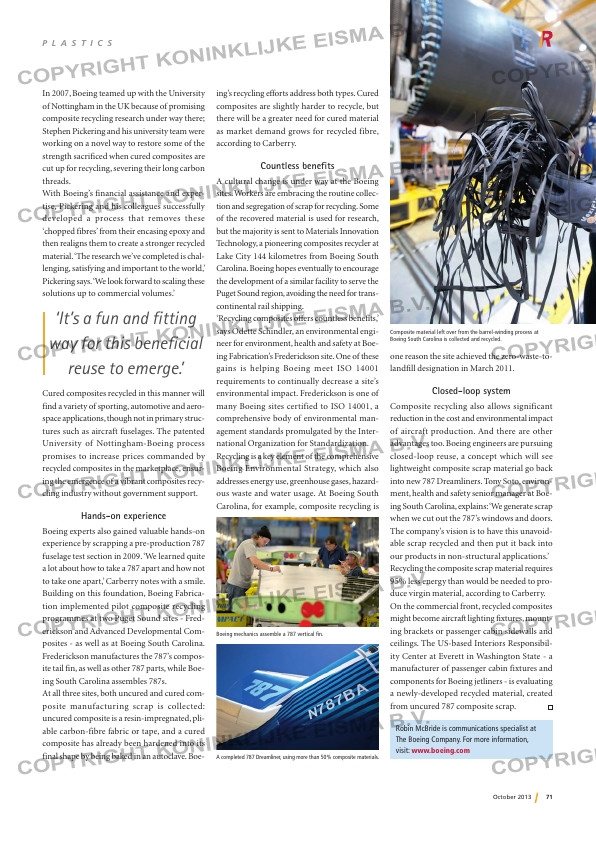Page 71 from: October 2013

71October 2013
P l a s t i c s
In 2007, Boeing teamed up with the University
of Nottingham in the UK because of promising
composite recycling research under way there;
Stephen Pickering and his university team were
working on a novel way to restore some of the
strength sacrificed when cured composites are
cut up for recycling, severing their long carbon
threads.
With Boeing’s financial assistance and exper-
tise, Pickering and his colleagues successfully
developed a process that removes these
‘chopped fibres’ from their encasing epoxy and
then realigns them to create a stronger recycled
material. ‘The research we’ve completed is chal-
lenging, satisfying and important to the world,’
Pickering says. ‘We look forward to scaling these
solutions up to commercial volumes.’
Cured composites recycled in this manner will
find a variety of sporting, automotive and aero-
space applications, though not in primary struc-
tures such as aircraft fuselages. The patented
University of Nottingham-Boeing process
promises to increase prices commanded by
recycled composites in the marketplace, ensur-
ing the emergence of a vibrant composites recy-
cling industry without government support.
Hands-on experience
Boeing experts also gained valuable hands-on
experience by scrapping a pre-production 787
fuselage test section in 2009. ‘We learned quite
a lot about how to take a 787 apart and how not
to take one apart,’ Carberry notes with a smile.
Building on this foundation, Boeing Fabrica-
tion implemented pilot composite recycling
programmes at two Puget Sound sites – Fred-
erickson and Advanced Developmental Com-
posites – as well as at Boeing South Carolina.
Frederickson manufactures the 787’s compos-
ite tail fin, as well as other 787 parts, while Boe-
ing South Carolina assembles 787s.
At all three sites, both uncured and cured com-
posite manufacturing scrap is collected:
uncured composite is a resin-impregnated, pli-
able carbon-fibre fabric or tape, and a cured
composite has already been hardened into its
final shape by being baked in an autoclave. Boe-
ing’s recycling efforts address both types. Cured
composites are slightly harder to recycle, but
there will be a greater need for cured material
as market demand grows for recycled fibre,
according to Carberry.
Countless benefits
A cultural change is under way at the Boeing
sites. Workers are embracing the routine collec-
tion and segregation of scrap for recycling. Some
of the recovered material is used for research,
but the majority is sent to Materials Innovation
Technology, a pioneering composites recycler at
Lake City 144 kilometres from Boeing South
Carolina. Boeing hopes eventually to encourage
the development of a similar facility to serve the
Puget Sound region, avoiding the need for trans-
continental rail shipping.
‘Recycling composites offers countless benefits,’
says Odette Schindler, an environmental engi-
neer for environment, health and safety at Boe-
ing Fabrication’s Frederickson site. One of these
gains is helping Boeing meet ISO 14001
requirements to continually decrease a site’s
environmental impact. Frederickson is one of
many Boeing sites certified to ISO 14001, a
comprehensive body of environmental man-
agement standards promulgated by the Inter-
national Organization for Standardization.
Recycling is a key element of the comprehensive
Boeing Environmental Strategy, which also
addresses energy use, greenhouse gases, hazard-
ous waste and water usage. At Boeing South
Carolina, for example, composite recycling is
one reason the site achieved the zero-waste-to-
landfill designation in March 2011.
Closed-loop system
Composite recycling also allows significant
reduction in the cost and environmental impact
of aircraft production. And there are other
advantages too. Boeing engineers are pursuing
closed-loop reuse, a concept which will see
lightweight composite scrap material go back
into new 787 Dreamliners. Tony Soto, environ-
ment, health and safety senior manager at Boe-
ing South Carolina, explains: ‘We generate scrap
when we cut out the 787’s windows and doors.
The company’s vision is to have this unavoid-
able scrap recycled and then put it back into
our products in non-structural applications.’
Recycling the composite scrap material requires
95% less energy than would be needed to pro-
duce virgin material, according to Carberry.
On the commercial front, recycled composites
might become aircraft lighting fixtures, mount-
ing brackets or passenger cabin sidewalls and
ceilings. The US-based Interiors Responsibil-
ity Center at Everett in Washington State – a
manufacturer of passenger cabin fixtures and
components for Boeing jetliners – is evaluating
a newly-developed recycled material, created
from uncured 787 composite scrap.
Robin McBride is communications specialist at
The Boeing Company. For more information,
visit: www.boeing.com
‘It’s a fun and fitting
way for this beneficial
reuse to emerge.’
Composite material left over from the barrel-winding process at
Boeing South Carolina is collected and recycled.
Boeing mechanics assemble a 787 vertical fin.
A completed 787 Dreamliner, using more than 50% composite materials.
p00_Boeing.indd 71 03-10-13 10:01



